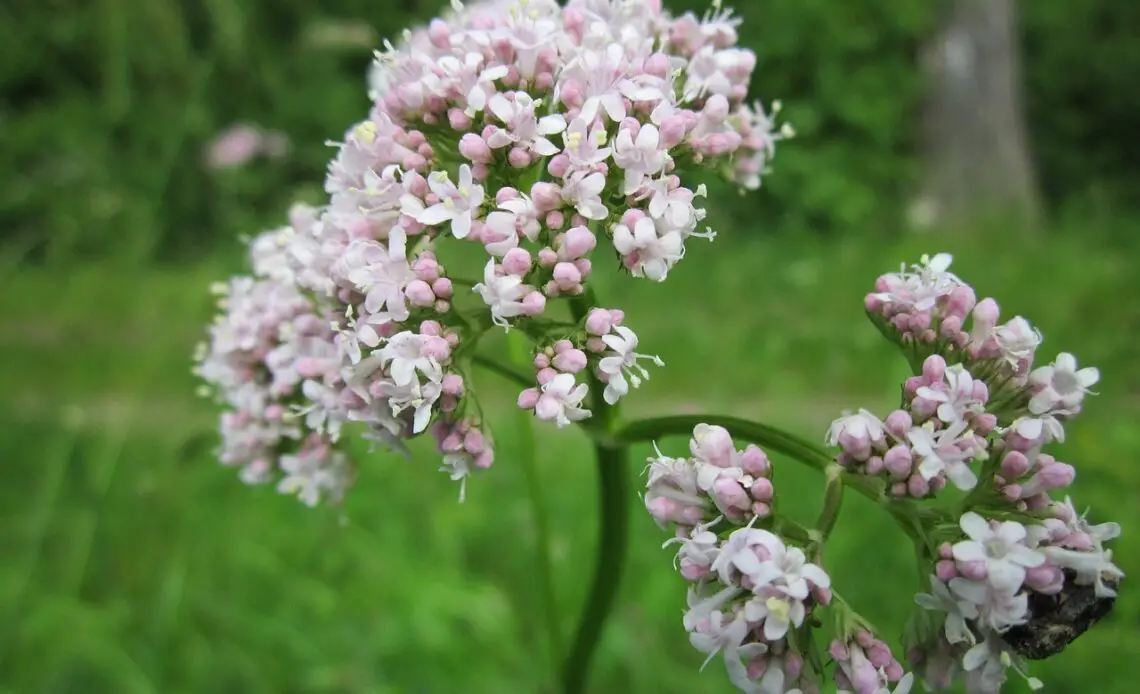
Last updated on May 22nd, 2023 at 11:39 am
Valerian belongs to the herb family Caprifoliaceae and the genus Valeriana. This herbaceous plant is perennial and is native to Europe and Asia.
The name Valerian owes its roots to two possible sources. One source was the Latin personal name “Valerius” or “Valeria.” The word later changed to “Valeriane” due to Old French influence. The resultant English word was “Valerian,” which came to be used as the plant’s name. Another possible source is the Latin word “valere” (to be strong, healthy).
This plant can also be identified by a few other common names Garden valerian (Valeriana Officinalis), Garden heliotrope (however, this does not relate it to Heliotropium), Setwall, and All-heal (however, this name is sometimes also used for plants in the Stachys genus).
It is worth noting that the Red valerian is sometimes called “valerian.” This plant is also grown in gardens. However, the plant is a completely different species (scientific name: Centranthus Ruber). It is from the same family; however, the two variants are not closely related.
The valerian plant has a diverse morphology and displays various features. The root comprises a hardy rhizome with multiple secondary roots and runners. Around the second year of growth, the plant develops a round and hollow stem. It grows up to a height between 80 and 120 cm. The plant has several branches originating at the top of the stem. The leaves have a pale green color on the upper surface. Yet, the color is considerably darker underneath the leaf.
Valerian’s stems bear several branches with white and pale pink flowers. The blooming period of the valerian flowers extends from May to August.
What Does The Valerian Flower Symbolize?
The valerian flower has historically been interpreted as a symbol of strength and vitality. This likely comes from the Latin sources of the plant’s name. The flowers have a mix of white and pale pink colors. In flower bouquets, valerian flowers symbolize friendship (pink) and loyalty (white). The valerian flower also symbolizes mindfulness and cognizance.
People in Ancient Egypt honored the valerian flower as their favorite animal – the cat – was attracted to these flowers. Also, in Medieval Europe, groomsmen in Sweden used to have valerian flowers attached to their dresses. This practice was done before the wedding to “ward off the envy of elves” and ensure that the wedding was conducted easily.
You may also be aware of the Pied Piper of Hamelin. Interestingly, in some versions of the story, the Piper uses valerian flowers as bait to lure the rats out.
All in all, the valerian flower symbolic meanings are:
- health
- strength
- readiness
- awareness of what is to come
Meaning Of The Valerian Flower Colors
White color
The white-colored valerian flower symbolizes loyalty and faith. It is used in bouquets as well.
Pink color
The pink valerian flower symbolizes friendship, mutual appreciation, and support.
Red color
Red valerian or Centranthus Ruber is a distant relative of the true valerian (or Valeriana Officinalis). This flower is also known by its common names, such as “Scarlet Lightning” or “Jupiter’s-Beard.” The red variant of the valerian symbolizes health and wellness. It is because the flower is often used for its medicinal properties.
Interesting Facts About The Valerian Flowers
- Valerian has long been used as a potent yet moderate sedative, migraine therapy, anticonvulsant, antibacterial, and pain reliever. It has no known negative side effects but is not designed for long-term use.
- The root of the Valerian plant is often reported to have a sedative or anti-anxiety effect. This plant part is sometimes used to treat insomnia and other sleep disorders.
- Pilgram Marpeck, a sixteenth-century reformer, prescribed valerian tea to a sick woman.
- John Gerard, a sixteenth-century herbalist, advocated using valerian for croup, convulsions, and bruises.
- Historically, valerian was used to “cure” epilepsy.
- Valerian was commonly used as a remedy by poorer people in Scotland and the north of England who did not have access to appropriate nourishment or other treatments.
- The typical faint smell of the valerian plant can only be detected when the roots and stem of the plant are fresh. Its intensity increases once the plant has dried considerably. Interestingly, the odor of the dry plant strongly attracts cats and has a very intoxicating effect on them.
- The root of the Red Valerian plant is used as a sedative to treat sleep disorders such as insomnia. As a result, it promotes the good health and well-being of the patient. There are no details about any side effects of red Valerian flowers. However, extreme caution should be exercised while allowing children near these flowers.
How To Grow Valerian Flowers
Valerians are tough and easy to grow, earning them a place in plenty of medicinal and ornamental gardens.
- Plant the valerian in moist but well-drained loam.
- Choose a spot where the plant can get full sun.
- Give them a consistent amount of light moisture to thrive.
- Apply nitrogen-rich fertilizer.
How To Care For Valerian Flowers
- Ensure the valerian plant receives about 1 inch of water per week in supplemental watering if there is an extended period without rain.
- Cover the soil with mulch to help retain moisture.
- Cut off the faded flowers before the seed forms.
Best Time To Gift Valerian Flowers
Based on the description and valerian flower meaning, this flower can be gifted for household decoration. You may also give pink Valerian flowers to a good friend with whom you share a close relationship.
Conclusion
The valerian flower has been around for quite a while. Its use in literature dates back thousands of years as a medicinal and botanical favorite. It is still in use today in a variety of fields.
If you want to know and learn more about flowers, we at PansyMaiden can help you. Check out our fun, easy-to-read, and informative flower-related content that you will surely enjoy!
